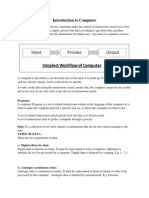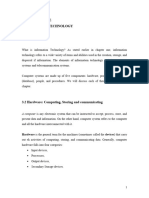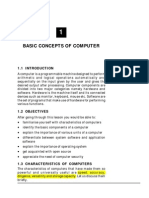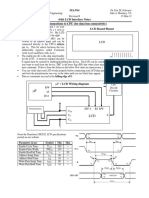Professional Documents
Culture Documents
Basic Fundamentals of Computer
Basic Fundamentals of Computer
Uploaded by
Ayushi AgrawalOriginal Description:
Original Title
Copyright
Available Formats
Share this document
Did you find this document useful?
Is this content inappropriate?
Report this DocumentCopyright:
Available Formats
Basic Fundamentals of Computer
Basic Fundamentals of Computer
Uploaded by
Ayushi AgrawalCopyright:
Available Formats
BASIC FUNDAMENTALS OF
COMPUTER
DIFFERENT PARTS OF A COMPUTER AND THEIR USES
The standard computer consists of a monitor, a
keyboard, a mouse and the system unit. One
can attach accessories such as printers and scanners by means of ports.
Increasingly in the workplace, computers are connected to printers and
other computers by means of a network.
The Monitor
This is the Visual Display Unit (VDU). There are various technologies for
the display unit, cathode ray tube (CRT) or Liquid Crystal Display (LCD)
or electro luminescent screens or the projector. The monitor or screen
displays your work. Facing it down reduces reflected glare from room
lights. This reflection may affect your sight. Monitors come in different
sizes
The system box
The system box is where all the computations that the computer
performs take place. Inside are the CPU processor, the motherboard,
the hard disk, any network or sound cards, memory chips (RAM),
printer ports (at the back) and the drive bays for floppy disks, Zip disks
or CDs. Outside the casings are the power buttons (ON/OFF and
Restart) with some additional facilities like the casing USB ports,
Webcams, etc..
The keyboard (Pressing)
This is the basic input device. It is one of the ways you can tell the
computer what to do. It consists of the standard typewriter keys as well
as a numeric keypad and function keys. You can use it to give the
computer commands, name folders and files, and type text in word
processing documents. The keyboard is made of three main categories
of keys with each used for a different purpose.
The Mouse (Clicking and Dragging)
This is another input device used to move a small white arrow pointer-
the Cursor (but the shape will change depending on the context in
which the mouse is being used) on the screen. By pointing and clicking
you can carry out commands. The computer may ask you to verify that
you are sure to rename a file, by clicking on the ëOkí button. A mouse is
primarily made of three parts: the buttons, the handling area, and the
sensor (rolling object or light). There are either one, two or three
mouse buttons. By default, a mouse has two buttons: left and right.
Most mice nowadays are also equipped with a wheel on top of the
middle button called the Scroll Button.
ANATOMY OF COMPUTER SYSTEM
A typical computer system irrespective of its size, class or type consists
of hardware and software, integrated and harmonized together to
perform computational work (scientific or military) or data processing.
COMPUTER HARDWARE
Hardware system: Computer hardware consists of the components
that can be physically handled. It refers to the physical units or machine
of functional units, which makes up the computer configuration which
is done to suit the goals and objectives of the user. The function of
these components is typically divided into three main categories: input,
output, and storage. Components in these categories connect to
microprocessors, specifically, the computerís central processing unit
(CPU), the electronic circuitry that provides the computational ability
and control of the computer, via wires or circuitry called a bus.
Hardware may be classified into Central Processing Units (CPU) and the
peripherals. The CPU entails Control Unit (CU), Arithmetic and Logic
Unit (ALU) and the Internal Memory Unit (IMU) or main memory. The
peripherals consist of the input, output and Auxiliary Storage Units.
computer is made up of five district elements to include:
1. A central processing unit (ALU and CU)
2. Input unit
3. Output unit
4. Storage unit (Internal and Auxiliary)
5. The communication network; ìBusî that links all the elements of the
system, and connects
6. External world. (Cables and Cords)
MOTHERBOARD:
The motherboard is a printed circuit board that connects other
components through the use of traces, or electrical pathways. The
motherboard is indispensable to the computer and provides the main
computing capability. Personal computers normally have one central
processing unit (CPU) on the motherboard.
THE CENTRAL PROCESSING UNIT (CPU)
‘This is the main brain of the computer that accepts data, performs
operations on the data and sends out the result.Information from an
input device or from the computerís memory is communicated via the
bus to the Central Processing Unit (CPU), which is the part of the
computer that translates commands and runs programs. It consists of
ALU and CU, and a single chip or series of chips that performs
arithmetic and logical calculations
INTRODUCTION TO THE INTERNET
Computer Network (Networking and Internetworking) Until recently,
getting a computer was mostly equivalent to getting a machine that
would be used to perform office-related assignments and other
calculations. This type of computer was commonly referred to as
standalone. A network is a group of computers linked together so that
they can share resources such as printers, software programs and
documents. Computer network is the interconnectivity of autonomous
computers. In order for two computers to share what they have, they
must establish some type of communication. This is easily done using a
cable and an appropriate object (a network card, also called NIC)
inserted in each computer. This means that a cable would go from this
object of one computer to the same type of object on the other
computer. This is perfectly possible to connect two computers. If you
have more than two computers, then you use a type of intermediary
object whose job is to "direct traffic". This object is called a hub
. For example, when one computer A requests to use or open a piece of
text that is located in a computer B but to print it in a printer that is
connected to a computer C, this intermediary object is able to know
what computer has the text, what computer has the printer, and what
computer needs these two services. For these reasons, most
connections use this intermediary object: the hub There are two types
of networking relationship: computer workstations (clients) are
connected to a number of central network servers, which allocate
resources. In a peer-to-peer relationship, computer workstations serve
each other: one workstation may have access to a printer and allocates
this resource to others in the network; another may have access to file
storage and allocates this to others (including the workstation with the
printer)
You might also like
- Operation & Programming Manual: P - S e R I e S P - 1 2 1 2 P - 1 2 2 5Document111 pagesOperation & Programming Manual: P - S e R I e S P - 1 2 1 2 P - 1 2 2 5M Serv67% (3)
- H-046-008674-00-2.0 C3100&C3510 Service ManualDocument137 pagesH-046-008674-00-2.0 C3100&C3510 Service ManualnikolozNo ratings yet
- After Effects Shortcuts PDFDocument10 pagesAfter Effects Shortcuts PDFcolourNo ratings yet
- Internet of ThingsDocument30 pagesInternet of ThingsAyushi AgrawalNo ratings yet
- Computer EssentialsDocument2 pagesComputer EssentialsRocio A RubecindoNo ratings yet
- SMT0021-8.6 VuPAKDocument152 pagesSMT0021-8.6 VuPAKhadiNo ratings yet
- Chapter 2Document17 pagesChapter 2haileNo ratings yet
- Workshop - I Lab ManualDocument36 pagesWorkshop - I Lab Manualatulya singhNo ratings yet
- Computer: Components of Computer SystemDocument5 pagesComputer: Components of Computer SystemMalik Ali BiadNo ratings yet
- Chapter Two:-: Computer SystemDocument134 pagesChapter Two:-: Computer SystemTolera TamiruNo ratings yet
- HMHDocument4 pagesHMHCraqihnoNo ratings yet
- Chapter - 2Document134 pagesChapter - 2elias asefaNo ratings yet
- Unit 2. Hardware ComponentsDocument10 pagesUnit 2. Hardware ComponentsRaju KumaarNo ratings yet
- Learning Activity Sheet # 1 TITLE: Assemble Computer HardwareDocument6 pagesLearning Activity Sheet # 1 TITLE: Assemble Computer HardwareAngelo VillanuevaNo ratings yet
- Module IT COM1 Unit 4Document15 pagesModule IT COM1 Unit 4Joshua DalmacioNo ratings yet
- 175 16cacca1b 2020052204230029Document119 pages175 16cacca1b 2020052204230029shrivastavabhoomi46No ratings yet
- 1 Computers FundamentalsDocument13 pages1 Computers Fundamentalsdevil's doubleNo ratings yet
- DocumentDocument4 pagesDocumentmanishkarnatak11.0118No ratings yet
- Comp Subj. k1Document6 pagesComp Subj. k1Christian BaytanNo ratings yet
- Computer SystemDocument4 pagesComputer SystemRohit RaoNo ratings yet
- Programmed Arithmetic Logical: Parts of A Computer in This PageDocument4 pagesProgrammed Arithmetic Logical: Parts of A Computer in This PagelhouieNo ratings yet
- Computer Fundamental Ist Year 2019 2 2019 09 12 1568286728-2Document30 pagesComputer Fundamental Ist Year 2019 2 2019 09 12 1568286728-2tvcartoon610No ratings yet
- Block DiagramDocument21 pagesBlock DiagramBhoomi JindalNo ratings yet
- C Language BasicsDocument61 pagesC Language Basicsinfotainment100% (1)
- Chapter # 1 Basic Concepts of Information Technology: XI Computer Science Page 1 of 28Document28 pagesChapter # 1 Basic Concepts of Information Technology: XI Computer Science Page 1 of 28sqamar68No ratings yet
- Chapter 2 - Computer SystemDocument18 pagesChapter 2 - Computer Systemhariye2225No ratings yet
- Group 1: Chapter Two 2 Computer OrganizationDocument12 pagesGroup 1: Chapter Two 2 Computer OrganizationtekleNo ratings yet
- Course: Introduction To Computers: Basic Computer ConceptsDocument18 pagesCourse: Introduction To Computers: Basic Computer ConceptsMaha AliNo ratings yet
- Notes On Computer PDFDocument19 pagesNotes On Computer PDFGolam Rasul KibriaNo ratings yet
- Overview of A Computer System.Document32 pagesOverview of A Computer System.grenamoNo ratings yet
- Computer System Components: Computing (Informatica)Document2 pagesComputer System Components: Computing (Informatica)Lorena ArroyoNo ratings yet
- Pdf&rendition 1-1 231031 112511Document51 pagesPdf&rendition 1-1 231031 112511archanav5703No ratings yet
- Anatomy of A ComputerDocument9 pagesAnatomy of A ComputerAnjuman AraaNo ratings yet
- Workbook Assessment Task 3 - Computer Hardware IPO Storage and NetworkDocument2 pagesWorkbook Assessment Task 3 - Computer Hardware IPO Storage and NetworkColeene TubieraNo ratings yet
- Coa Lab ManualDocument33 pagesCoa Lab ManualSENTHIL RNo ratings yet
- (OS) Operating SystemDocument21 pages(OS) Operating SystemSa Kh AauNo ratings yet
- Computers: Inventor of ComputerDocument25 pagesComputers: Inventor of ComputerJohn Philip VuelbaNo ratings yet
- Components of The Data ProcessingDocument4 pagesComponents of The Data ProcessingmuhororoNo ratings yet
- Introduction To Computing To FASADocument118 pagesIntroduction To Computing To FASAabdoulayNo ratings yet
- ComputerSCIENCE 1Document7 pagesComputerSCIENCE 1Mehtab KhanNo ratings yet
- Chapter Three MISDocument50 pagesChapter Three MISfasilsoft123No ratings yet
- COMPUTER NotesDocument107 pagesCOMPUTER NotesChilufya MubangaNo ratings yet
- CH-1 Introduction To Computer System and ProgrammingDocument21 pagesCH-1 Introduction To Computer System and ProgrammingpriyeshNo ratings yet
- Basic Concepts of Computer (1.25 MB)Document32 pagesBasic Concepts of Computer (1.25 MB)poo235No ratings yet
- Block Diagram of Computer & Input Output UnitsDocument40 pagesBlock Diagram of Computer & Input Output Unitshimanshu.bcastudent23.23664No ratings yet
- 11computer Science-Computer System Overview-NotesDocument12 pages11computer Science-Computer System Overview-NotesDeepanshu GuptaNo ratings yet
- Theme Hardware Input Output DevicesDocument17 pagesTheme Hardware Input Output DevicesExequiel TacachoNo ratings yet
- ComputerDocument8 pagesComputerBeth AlcontinNo ratings yet
- Presented By:: Charanjit. Vig Chetna - Bhat Devdatt - Kamble Meghna - Pednekar Satinder - Aggarwal Sumeet - SinghDocument60 pagesPresented By:: Charanjit. Vig Chetna - Bhat Devdatt - Kamble Meghna - Pednekar Satinder - Aggarwal Sumeet - SinghaveegoNo ratings yet
- Introduction To Computing: What Is A Computer?Document11 pagesIntroduction To Computing: What Is A Computer?Nirmala BandooNo ratings yet
- What Is Computer Hardware (IT FUNDAMNETALS)Document6 pagesWhat Is Computer Hardware (IT FUNDAMNETALS)JSON AMARGANo ratings yet
- Fundamental of IS Chapter 2Document28 pagesFundamental of IS Chapter 2Tesfaye DesalegnNo ratings yet
- A Programmable MachineDocument1 pageA Programmable Machinediether_faropaldinoNo ratings yet
- Basic Concepts of Computer (1.25 MB)Document32 pagesBasic Concepts of Computer (1.25 MB)abhi_txt90No ratings yet
- ENGLAISDocument15 pagesENGLAISDan BurgNo ratings yet
- Computr Appltion 1 and 2Document46 pagesComputr Appltion 1 and 2george manNo ratings yet
- HardwareDocument22 pagesHardwarealexNo ratings yet
- ComputerDocument13 pagesComputeryicho864No ratings yet
- DC 102 Module 1 Lesson 1Document12 pagesDC 102 Module 1 Lesson 1jerome paulinesNo ratings yet
- Ict Hand BookDocument25 pagesIct Hand BookSamaeel UrielNo ratings yet
- Block Diagram of A ComputerDocument4 pagesBlock Diagram of A Computerwoyaf61625No ratings yet
- Parts of Computer and Input and Output DevicesDocument27 pagesParts of Computer and Input and Output Devicesdua tanveerNo ratings yet
- Unit 1 Notes AutonomousDocument108 pagesUnit 1 Notes AutonomoussirishaNo ratings yet
- On The Insert TabDocument6 pagesOn The Insert TabAyushi AgrawalNo ratings yet
- Mail MergeDocument10 pagesMail MergeAyushi AgrawalNo ratings yet
- Amit (S K)Document68 pagesAmit (S K)Ayushi AgrawalNo ratings yet
- A Project Report OF ABHISHEKDocument44 pagesA Project Report OF ABHISHEKAyushi AgrawalNo ratings yet
- Bba Project For 3r and 5th SemDocument48 pagesBba Project For 3r and 5th SemAyushi AgrawalNo ratings yet
- Framework For Preparation & Presentation of Financial StatementsDocument9 pagesFramework For Preparation & Presentation of Financial StatementsAyushi AgrawalNo ratings yet
- A Project Report On To Study The Brand PDocument41 pagesA Project Report On To Study The Brand PAyushi AgrawalNo ratings yet
- Nationalisation of Banks in India-12Document17 pagesNationalisation of Banks in India-12Ayushi AgrawalNo ratings yet
- VI Basic Commands: DW D DDDocument1 pageVI Basic Commands: DW D DDsrikk595No ratings yet
- Custom DateTimePicker - Custom Controls WinForm C # - RJ Code AdvanceDocument12 pagesCustom DateTimePicker - Custom Controls WinForm C # - RJ Code AdvanceToan Nguyen ManhNo ratings yet
- SMTWOperating GuideDocument199 pagesSMTWOperating GuideRolando Nunez del Prado B.No ratings yet
- Bently PlusDocument417 pagesBently Plusasdfg1hNo ratings yet
- 25 - Inserting Report CommandsDocument75 pages25 - Inserting Report Commandssokaiya ramanNo ratings yet
- MP Lab Report # 4Document6 pagesMP Lab Report # 4Hassan Zeb Akhtar ZebNo ratings yet
- Letawin Manual LM 550A 3Document69 pagesLetawin Manual LM 550A 3An AccountNo ratings yet
- Control of Packed Goods - Net Version: Manual Number: KTI-07-01/05/06/ADocument28 pagesControl of Packed Goods - Net Version: Manual Number: KTI-07-01/05/06/AFernando Chacmana LinaresNo ratings yet
- The Spectral Image Processing System (SIPS) - Interactive Visualization and Analysis of Imaging Spectrometer DataDocument19 pagesThe Spectral Image Processing System (SIPS) - Interactive Visualization and Analysis of Imaging Spectrometer DatanajiNo ratings yet
- Discover 3D TutorialDocument77 pagesDiscover 3D TutorialDomingo CaroNo ratings yet
- Autodesk Robot Structural Analysis ProfeDocument246 pagesAutodesk Robot Structural Analysis ProfeCarlos SousaNo ratings yet
- More About Gimp Notes and QaDocument21 pagesMore About Gimp Notes and QaVirti DesaiNo ratings yet
- 4-Bit LCD Interface NotesDocument7 pages4-Bit LCD Interface NotesKaik Wulck BassanelliNo ratings yet
- Webcam Photo BoothDocument136 pagesWebcam Photo BoothjohaberNo ratings yet
- User'S Manual: Spin 1Document69 pagesUser'S Manual: Spin 1Debbie ANo ratings yet
- ZoomIt v7.1 ShortcutsDocument1 pageZoomIt v7.1 Shortcutstech.quegiangNo ratings yet
- Computer: Python Tkinter ButtonDocument3 pagesComputer: Python Tkinter ButtonJer FelysseNo ratings yet
- Multi Input Device System For DiRT Rally 2 0 MasterDocument37 pagesMulti Input Device System For DiRT Rally 2 0 MasterRalf BassaniNo ratings yet
- 1 EN EchoWaveII Software User Manual 1.8.0 PDFDocument182 pages1 EN EchoWaveII Software User Manual 1.8.0 PDFGensulin BennaiNo ratings yet
- Autodesk Robot Structural Analysis Training ManualDocument108 pagesAutodesk Robot Structural Analysis Training ManualMuhammad Z AwanNo ratings yet
- How To Make 3 D Effect On Corel DrawDocument20 pagesHow To Make 3 D Effect On Corel DrawSatyajeet BhagatNo ratings yet
- Motor Efi Software ManualDocument149 pagesMotor Efi Software ManualwillyhuaNo ratings yet
- Casio Edifice ManualDocument3 pagesCasio Edifice ManualMistah RoflcopterNo ratings yet
- To-1 Bahasa InggrisDocument19 pagesTo-1 Bahasa InggrisDjunaedi EdiNo ratings yet
- Human Computer Interaction Cognitive ModelsDocument12 pagesHuman Computer Interaction Cognitive Modelsvicky arooraNo ratings yet
- FluidScan FL350 Manual v.1.5Document82 pagesFluidScan FL350 Manual v.1.5angel017No ratings yet


































































































